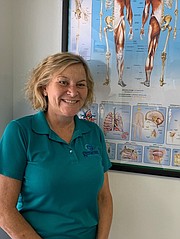By Hannah Foster-Middleton, BSc (Hons)Physiotherapy, MCSP, SRP
Genesis Physiotherapy
There’s more than one meaning to our column heading this week, but in this instance, I am using the phrase literally and want to talk to you about poor posture and its harmful effect on the body. More and more people are working from home under less-than-ideal conditions. Some are also having to oversee their children’s home-schooling, so we may have both parents and children adopting less than ideal posture as they sit and work at a computer, iPad or laptop. We also have teachers in a similar predicament, now having to teach their classes online, which is likely to mean far more sitting in front of a screen than previously. This is the perfect time with the imminent school Summer break for teachers, parents and children to address the adverse effects of bad posture and change their habits.
Poor posture, correctly called postural dysfunction, is a description of the spine being in an unnatural position, meaning not straight but with the curves emphasised. Prolonged poor positioning puts stress on the muscles, joints and vertebrae which can result in various painful conditions. Perhaps the most common is low back pain but research shows that complaints of neck, shoulder and arm pain are becoming more frequent. Postural dysfunction also has an impact on feet and knees for those who have added a fitness regime, particularly running or jogging. A variety of painful symptoms may present as body aches or pain in the upper or lower back, the neck, shoulder and arms, as well as the hips, knees and ankles. Muscle fatigue can also cause headaches due to poor posture and the resulting tension involving the neck and shoulders.
Poor posture: Slouching, rounded shoulders, hunchback, tilting head forward, bent knees
Good posture: Balanced upright posture, with a straight line from the ear to the shoulder to the hip.
Poorposture. Shoulder blades excessively back, arching of the lower back, locked knees, pot belly.
Multiple causes of postural dysfunction may include:
•Lack of education or awareness of correct posture
•Sedentary lifestyle
•Occupational demands
•Poor ergonomic workstations
•Decreased fitness
•Joint stiffness
•Muscle weakness
•Muscle tightness
•Poor core stability
Physiotherapy treatment may significantly help to minimise, if not eliminate, postural dysfunction. Most patients will experience decreased pain once their posture is corrected.
Therapy may include: assessment and diagnosis of postural habits; postural education and training; manual therapy and soft tissue massage; dry needling; Postural taping; electrotherapy; joint mobilisation; activity modification advice; advice regarding ergonomic workstations; Pilates exercises and corrective exercises and movements to improve flexibility, strength and posture.
Do any of the above problems or symptoms apply to you? Do you habitually slump on the couch to watch tv or prop yourself up in bed on a soft pillow, rounding your back to read or use your cell phone? If you have children, do they lie on the floor to watch TV, text their friends or do their homework? All of these actions put your spine out of alignment and create unconscious bad habits which cause you pain. Suffering is unnecessary and solutions are available. If you are concerned, make an appointment so that we can discuss the best treatment for your particular problem. Don’t get bent out of shape - good posture boosts your confidence and can make you look and feel better. Who doesn’t want that?
•For questions and comments, call Hannah Foster-Middleton at Genesis at 356 4806, e-mail genesisphysiotherapy@gmail.com or visit www.physiotherapybahamas.com





Comments
Use the comment form below to begin a discussion about this content.
Sign in to comment
Or login with:
OpenID